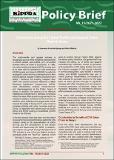Policy Brief No. 15 of 2021-2022 on Constraints along the Cotton Textile and Apparel Value Chain in Kenya
View/
Publication Date
2021Author
Type
KIPPRA Publicationsviews
downloads
Metadata
Show full item recordBy
Njoroge, Lawrence & Malicha, Wario
Abstract/
The cotton-textile and apparel industry is recognized as one of the industries with potential to absorb skilled, semi-skilled, and non-skilled workers within its chain of production. In 1986, the cotton textile and apparel (CTA) industry was at its peak with 52 operational mills employing 42,000 people and close to 200,000 households engaged in cotton farming, making it second after the civil service industry in terms of employment ability1 2. However, the industry collapsed after 1984, with Global Economic Reforms of 1990s Structural Adjustment Programmes (SAPs), trade liberalization policies, embezzlement, and mismanagement at the Cotton Board of Kenya. In addition, the absence of an effective institutional arrangement to address constraints within the value chain presents a great risk to the industry’s ability to contribute to the economy. In addition, poor institutional arrangements further impede the ability of Kenya’s CTA value chain to compete globally with other countries such as China, or regionally with nations such as South Africa and Egypt posing a substantial growth threat to the industry
Subject/
Economic Reforms; Value Chain; Improved Perfomance; Growth and Opportunity; Economy
Publisher
Kenya Institute for Public Policy Research and Analysis (KIPPRA)Series
PB/15/2021-2022Collections
- Policy Briefs [165]

